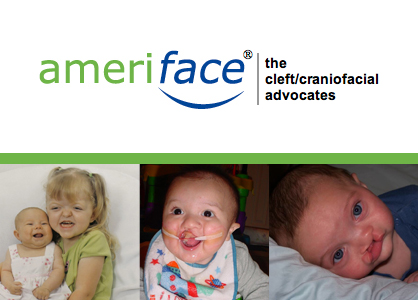AmeriFace: Changing the face of cleft-related nonprofits
Debbie Oliver learned about cleft lip not from a commercial or ad, but from personal experience. Her daughter Emily* (name changed to protect privacy) was born with a complete bilateral cleft lip and palate, and had palate closure at 8 months old and lip repair at 10 weeks. But her trials were far from over. A bilateral cleft means the cleft goes through not just the lip, but also the gum. Emily’s gumline was in three different places.
Oliver still remembers the first time she took her daughter out in public. A stranger took one look at 6-week-old Emily and asked, “Were you on drugs when you were pregnant?” Stunned, Oliver said nothing and walked away. Today, she would have used the opportunity to spread awareness.
As a child, Emily endured teasing and bullying so severe that her mother often wanted to intervene. Emily, though, wanted to handle things on her own.
To make matters worse, Oliver’s insurance refused to pay for many of Emily’s treatments. The mother turned to the Internet for help, but most of sites only explained the medical aspects of the conditions, and didn’t discuss how to get surgeries covered.
“It doesn’t matter if we understand the surgical procedure if our insurance company won’t cover it,” Oliver said. “They can do all the research and all of this backbreaking work, but if the insurance company won’t pay for it, it doesn’t do our kids any good.”
She decided to launch a basic website to help parents navigate their insurance options. Almost overnight, the site blossomed.
“I never went into it thinking this could be big outreach or we could have a support network,” Oliver revealed. “While we were in the midst of those early treatments … I didn’t even see it as outreach. You just did what you did for other families you came in contact with.”
That was the beginning of AmeriFace, a nonprofit that reaches out to the hundreds of thousands of people with facial differences, whether they have complex cranial facial differences such as cleft lip and palate or acquired differences such as burns, accidents, trauma and oral cancer. As the largest and most active support group for the cleft and craniofacial community, AmeriFace provides these individuals with the one-on-one support they need.
After many prolonged fights with her own insurance carrier, Oliver became passionate about preventing others from enduring similar struggles. She jumped at the chance to advocate for others and is now executive director of AmeriFace. One case she worked on involved six pounds of paperwork, several months of fighting and endless appeals, but Oliver refused to give up until her team won. Today the case is a precedent in the state of Nevada.
Although many believe that these conditions only occur in developing countries – Oliver blames the media for this misconception – cleft lip and palate is actually the most common birth defect in the United States today, appearing in one in every 600 babies. .
“(These misconceptions are) due to the big money advertising budgets of United States-based, but internationally focused, cleft-related organizations,” Oliver,said. “The public are also led to believe that for $250, one surgery (is covered) … that (the) problem is solved. Nothing could be further from the truth.”
Cleft lip and/or palate occur when a fissure forms in the room of the mouth or in the lip beneath the nostril, caused by incomplete fusion of the palate, and can be a result of genetic or environmental factors, or can occur spontaneously.
Cleft lip and palate are complicated conditions not solved with a single surgery. Even after the lip is closed and the nose is somewhat repaired, revision surgeries are needed due to accommodate growth. Children may wind up needing bone graft surgery, in which a bone from the hip is transplanted into the gumline. As teenagers, they may need midface advancement surgery because the upper jaw and cheekbone have a tendency to grow slower than the rest of the face. Children born with these conditions often struggle to breastfeed – akin to drinking through a straw with a hole in it – and may need special feeders.
In all, Oliver reports the treatments can last decades.
But parents are left with little choice: Their children need to be able to bite, chew, swallow and breathe.
Speech therapy is often necessary as kids struggle to learn to “use their new equipment.” Oliver recalls a man so difficult to understand that people often hung up the phone on him.
These people face not just medical challenges, but also stigma and judgment from society. Adults stare. Children tease and bully.
“It seems an open invitation for some to jump on that bandwagon because somebody is a little different,” Oliver noted.
Health insurance rarely serves as a recourse for patients. Some insurance companies argue that the palate has already been closed and a secondary procedure is not necessary, or that the procedures are cosmetic and not reconstructive.
“If my daughter is going in for a rhinoplasty, it is not just because she wants a cute, perky nose. It’s because part of her nose was missing when she was born,” Oliver explained. Insurance companies, however, do not always see the difference. That is, to Oliver, one of AmeriFace’s main fights.
All of these long years of effort, though, are paying off. July is recognized as National Cleft & Craniofacial Awareness & Prevention Month by the Centers for Disease Control and is featured on the U.S. Department of Health & Human Services National Health Observances Calendar.
For more information, visit AmeriFace at www.ameriface.org.
Tagged in: lux exclusives, charity, nonprofit, philanthropy, organization, ameriface, craniofacial, cleft lip, cleft palate,

LadyLUX via AmeriFace



